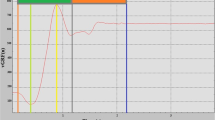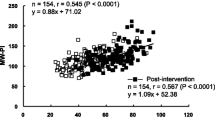Abstract
Poor performance of sit-to-stand (STS) has been identified as one of the predictors of fall risk among elderly adults. This study examined differences in the whole body center of mass (COM) kinematic variables in relation to the regions of stability between elderly adults with difficulty in STS and healthy individuals. Whole body motion data while performing STS were collected from 10 young, 10 elderly and 10 elderly subjects with difficulty in STS. Young subjects were also asked to stand up with their trunk purposely bent forward. The regions of stability were defined with COM position at seat-off and its instantaneous velocity (ROSv) or peak acceleration (ROSa), using a single-link-plus-foot inverted pendulum model. Peak COM accelerations prior to seat-off differed significantly among groups; however, no significant differences were detected in its velocities at seat-off. The ROSa demonstrated a better ability to discriminate elderly adults with difficulty from healthy individuals. Although a similar COM momentum was observed at seat-off, how the momentum was controlled differed between healthy individuals and individuals with difficulty in STS. ROSa could provide insight into how the COM momentum is controlled prior to seat-off, which could be used to differentiate individuals with functional limitations from healthy individuals.







Similar content being viewed by others
References
Alexander, N. B., M. M. Gross, J. L. Medell, and M. R. Hofmeyer. Effects of functional ability and training on chair-rise biomechanics in older adults. J. Gerontol. A Biol. Sci. Med. Sci. 56(9):M538–M547, 2001.
Bhatt, T., J. D. Wening, and Y. C. Pai. Adaptive control of gait stability in reducing slip-related backward loss of balance. Exp. Brain Res. 170(1):61–73, 2006.
Bohannon, R. W. Reference values for the five-repetition sit-to-stand test: a descriptive meta-analysis of data from elders. Percept. Mot. Skills 103(1):215–222, 2006.
Butler, P. B., A. V. Nene, and R. E. Major. Biomechanics of transfer from sitting to the standing position in some neuromuscular diseases. Physiotherapy 77(8):521–525, 1991.
Campbell, A. J., M. J. Borrie, and G. F. Spears. Risk factors for falls in a community-based prospective study of people 70 years and older. J. Gerontol. 44(4):M112–M117, 1989.
Chou, L. S., K. R. Kaufman, R. H. Brey, and L. F. Draganich. Motion of the whole body’s center of mass when stepping over obstacles of different heights. Gait Posture 13(1):17–26, 2001.
Dawson, D., G. Hendershot, and J. Fulton. Aging in the eighties. Functional limitations of individuals age 65 and over. Adv. Data Vital Health Stat. 133:1–12, 1987.
Doorenbosch, C. A., J. Harlaar, M. E. Roebroeck, and G. J. Lankhorst. Two strategies of transferring from sit-to-stand; the activation of monoarticular and biarticular muscles. J. Biomech. 27(11):1299–1307, 1994.
Fan, J., S. Upadhye, and A. Worster. Understanding receiver operating characteristic (ROC) curves. CJEM 8(1):19–20, 2006.
Fujimoto, M., and L. S. Chou. Dynamic balance control during sit-to-stand movement: an examination with the center of mass acceleration. J. Biomech. 45(3):543–548, 2012.
Gross, M. M., P. J. Stevenson, S. L. Charette, G. Pyka, and R. Marcus. Effect of muscle strength and movement speed on the biomechanics of rising from a chair in healthy elderly and young women. Gait Posture 8(3):175–185, 1998.
Hahn, M. E., and L. S. Chou. Age-related reduction in sagittal plane center of mass motion during obstacle crossing. J. Biomech. 37(6):837–844, 2004.
Harper, C. M., and Y. M. Lyles. Physiology and complications of bed rest. J. Am. Geriatr. Soc. 36(11):1047–1054, 1988.
Hirschfeld, H., M. Thorsteinsdottir, and E. Olsson. Coordinated ground forces exerted by buttocks and feet are adequately programmed for weight transfer during sit-to-stand. J. Neurophysiol. 82(6):3021–3029, 1999.
Hodge, W. A., K. L. Carlson, R. S. Fijan, R. G. Burgess, P. O. Riley, W. H. Harris, and R. W. Mann. Contact pressures from an instrumented hip endoprosthesis. J. Bone Joint Surg. Am. 71(9):1378–1386, 1989.
Hughes, M. A., B. S. Myers, and M. L. Schenkman. The role of strength in rising from a chair in the functionally impaired elderly. J. Biomech. 29(12):1509–1513, 1996.
Hughes, M. A., and M. L. Schenkman. Chair rise strategy in the functionally impaired elderly. J. Rehabil. Res. Dev. 33(4):409–412, 1996.
Hughes, M. A., S. A. Studenski, D. K. Weiner, and R. M. Long. Chair rise strategies in the elderly. Clin. Biomech. 9(3):187–192, 1994.
Ikeda, E. R., M. L. Schenkman, P. O. Riley, and W. A. Hodge. Influence of age on dynamics of rising from a chair. Phys. Ther. 71(6):473–481, 1991.
Leon, J., and T. Lair. Functional Status of the Noninstitutionalized Elderly: Estimates of ADL and IADL Difficulties. DHHS Publication No. (PHS) 90-3462. Rockville, MD: Public Health Service, 1990.
Lindemann, U., H. Claus, M. Stuber, P. Augat, R. Muche, T. Nikolaus, and C. Becker. Measuring power during the sit-to-stand transfer. Eur. J. Appl. Physiol. 89(5):466–470, 2003.
Muir, S. W., K. Berg, B. Chesworth, and M. Speechley. Use of the Berg Balance Scale for predicting multiple falls in community-dwelling elderly people: a prospective study. Phys. Ther. 88(4):449–459; discussion 460–461, 2008.
Nevitt, M. C., S. R. Cummings, S. Kidd, and D. Black. Risk factors for recurrent nonsyncopal falls. A prospective study. JAMA 261(18):2663–2668, 1989.
Pai, Y. C., B. J. Naughton, R. W. Chang, and M. W. Rogers. Control of body centre of mass momentum during sit-to-stand among young and elderly adults. Gait Posture 2:109–116, 1994.
Pai, Y. C., and J. Patton. Center of mass velocity-position predictions for balance control. J. Biomech. 30(4):347–354, 1997.
Pai, Y. C., J. D. Wening, E. F. Runtz, K. Iqbal, and M. J. Pavol. Role of feedforward control of movement stability in reducing slip-related balance loss and falls among older adults. J. Neurophysiol. 90(2):755–762, 2003.
Papa, E., and A. Cappozzo. A telescopic inverted-pendulum model of the musculo-skeletal system and its use for the analysis of the sit-to-stand motor task. J. Biomech. 32(11):1205–1212, 1999.
Papa, E., and A. Cappozzo. Sit-to-stand motor strategies investigated in able-bodied young and elderly subjects. J. Biomech. 33(9):1113–1122, 2000.
Pavol, M. J., and Y. C. Pai. Feedforward adaptations are used to compensate for a potential loss of balance. Exp. Brain Res. 145(4):528–538, 2002.
Savelberg, H. H., A. Fastenau, P. J. Willems, and K. Meijer. The load/capacity ratio affects the sit-to-stand movement strategy. Clin. Biomech. (Bristol, Avon) 22(7):805–812, 2007.
Scarborough, D. M., D. E. Krebs, and B. A. Harris. Quadriceps muscle strength and dynamic stability in elderly persons. Gait Posture 10(1):10–20, 1999.
Scarborough, D. M., C. A. McGibbon, and D. E. Krebs. Chair rise strategies in older adults with functional limitations. J. Rehabil. Res. Dev. 44(1):33–42, 2007.
Schenkman, M., R. A. Berger, P. O. Riley, R. W. Mann, and W. A. Hodge. Whole-body movements during rising to standing from sitting. Phys. Ther. 70(10):638–648; discussion 648–651, 1990.
Schenkman, M., M. A. Hughes, G. Samsa, and S. Studenski. The relative importance of strength and balance in chair rise by functionally impaired older individuals. J. Am. Geriatr. Soc. 44(12):1441–1446, 1996.
Schultz, A. B., N. B. Alexander, and J. A. Ashton-Miller. Biomechanical analyses of rising from a chair. J. Biomech. 25(12):1383–1391, 1992.
Tideiksaar, R. Fall prevention in the home. Top. Rehabil. 3(1):57–64, 1987.
Tiedemann, A., H. Shimada, C. Sherrington, S. Murray, and S. Lord. The comparative ability of eight functional mobility tests for predicting falls in community-dwelling older people. Age Ageing 37(4):430–435, 2008.
Tinetti, M. E., M. Speechley, and S. F. Ginter. Risk factors for falls among elderly persons living in the community. N. Engl. J. Med. 319(26):1701–1707, 1988.
Tinetti, M. E., T. F. Williams, and R. Mayewski. Fall risk index for elderly patients based on number of chronic disabilities. Am. J. Med. 80(3):429–434, 1986.
Whitney, S. L., D. M. Wrisley, G. F. Marchetti, M. A. Gee, M. S. Redfern, and J. M. Furman. Clinical measurement of sit-to-stand performance in people with balance disorders: validity of data for the Five-Times-Sit-to-Stand Test. Phys. Ther. 85(10):1034–1045, 2005.
Winter, D. A. Biomechanics and Motor Control of Human Movement. New York: Wiley, 1990.
Woltring, H. J. A FORTRAN package for generalized, cross-validatory spline smoothing and differentiation. Adv. Eng. Softw. 8(2):104–113, 1986.
Yang, F., D. Espy, and Y. C. Pai. Feasible stability region in the frontal plane during human gait. Ann. Biomed. Eng. 37(12):2606–2614, 2009.
Acknowledgments
The authors would like to thank Tzurei Chen for her help with data collection.
Conflict of interest
We declare that we have no commercial associations that might pose a conflict of interest in connection with the article.
Author information
Authors and Affiliations
Corresponding author
Additional information
Associate Editor Thurmon E. Lockhart oversaw the review of this article.
Associate Editor Michael S. Detamore oversaw the review of this article.
Electronic supplementary material
Below is the link to the electronic supplementary material.
Rights and permissions
About this article
Cite this article
Fujimoto, M., Chou, LS. Region of Stability Derived by Center of Mass Acceleration Better Identifies Individuals with Difficulty in Sit-to-Stand Movement. Ann Biomed Eng 42, 733–741 (2014). https://doi.org/10.1007/s10439-013-0945-9
Received:
Accepted:
Published:
Issue Date:
DOI: https://doi.org/10.1007/s10439-013-0945-9




